![]()
![]()
![]()
Use LEFT and RIGHT arrow keys to navigate between flashcards;
Use UP and DOWN arrow keys to flip the card;
H to show hint;
A reads text to speech;
41 Cards in this Set
- Front
- Back
|
What are the normal respiratory features in a newborn baby ?
|
1. Respiratory rate 35 - 45 per min.
2. No recession 3. No grunting 4. No cyanosis 5. No stridor 6. No apnoea 7. No nasal flare |
|
|
What are the clinical features of respiratory distress in a child ?
|
1. Respiratory rate of more than 60 per min.
2. Recession 3. Grunting 4. Cyanosis |
|
|
What are the pulmonary causes of Respiratory Distress in neonates ?
|
1. RDS
2. MAS 3. TTN 4. Pneumonia 5. Pneumothorax 6. Pulmonary haemorrhage 7. Congenital lung abnormalities 8. Hyaline membrane disease |
|
|
What are the extra-pulmonary causes of Respiratory Distress in neonates ?
|
1. Cerebral abnormalaties
2. Choanal atreasie 3. Micrognathis 4. T-O fistula 5. Cardiac abnormalities 6. Diaphragmantic hernia 7. Septicaemia |
|
|
List the special investigations you would employ to confirm the underlying cause of Respiratory Distress.
|
1. Chest radiograph
2. FBC 3. CRP 4. Blood culture 5. Hyperoxia test 6. ABG 7. Acid-base 8. Oxygen saturation |
|
|
What is the percentage of oxygen saturation needed to alleviate cyanosis in a preterm and term neonate, respectively ?
|
Preterm- 88 - 92 %
Term- 92 - 95 % |
|
|
What is the arterial pressure for oxygen needed to alleviate cyanosis in a preterm and term neonate, respectively ?
|
Preterm- 60 - 75 mmHg
Term- 60-90 mmHg |
|
|
What are the guidelines for referral in a neonate with Respiratory Distress ?
|
1. Severe grunting despite CPAP
2. Severe rib recession despite CPAP 3. Apnoea 4. PaCO2 > 7.5 kPa 5. Respiratory acidosis 6. Central cyanosis |
|
|
What are the dangers of too little oxygen in neonates ?
|
Hypoxia
Acidaemia Death |
|
|
What are the dangers of too much oxygen in neonates ?
|
Retinopathy of prematurity
Bronchopulmonary dysplasia |
|
|
Discuss the pathogenesis of ROP.
|
High levels of oxygen cause firstly a vasoconstrictive phase. Then a prolifitive phase- abnormal growth of retinal vessels which lead to bleeding in vitreous and eventually retinal detachment. This can cause blindness or regression.
|
|
|
Define: Bronchopulmonary dysplasia.
|
A condition characterized by any preterm baby <32 gestational weeks still requiring supplemental oxygen at 36 gestational weeks.
|
|
|
What are the risk factors for BPD ?
|
1. Immaturity
2. Oxygen toxicity 3. Baro- and volutrauma 4. Infection 5. Patent ductus artereosus |
|
|
What are the radiological features of a neonate with BPD ?
|
1. Diffuse haziness
2. Cystic |
|
|
Discuss the pathogenesis of BPD.
|
Firstly cellular and interstitial injury occurs causing fibrosis. This leads to cellular hyperplasia and airway muscularisation and hyperreactivity.
|
|
|
List the aetiology of hyaline membrane disease.
|
1. Preterm babies
2. Asphyxia 3. Infant diabetic mother |
|
|
True or false: Hyaline membrane disease is characterized by a pneumocyte 2 deficiency.
|
False. It is caused by a surfactant deficiency.
|
|
|
Discuss the pathophysiology of MAS.
|
Atelectasis and hyperinflation occurs. This causes hypoxemia and hypercapnia. Persistent pulmonary hypertension develops. Chemical pneumonitis occurs which results in surfactant inactivation.
|
|
|
Discuss the clinical presentation of transient tachypnoea of a neonate (TTN).
|
1. In term babies
2. Elective caesarean babies 3. Mild to moderate respiratory distress 4. Can be asymptomatic |
|
|
Discuss the chest radiograph of a baby with transient tachypnoea of the newborn (TTN).
|
1. Perihilar streaking
2. Fluid in lung fissures 3. Increased lung volumes |
|
|
Early onset group B streptococci disease in newborns usually presents with ?
|
Pneumonia.
|
|
|
True or false: The chest x-ray of a baby with pneumonia might be similar to that of a baby with HMD.
|
True.
|
|
|
A baby of 32 gestational weeks is 3 hours old and presents with respiratory distress. What is the most likely underlying condition and what is the cause ?
|
Hyaline membrane disease, and a decrease in surfactant.
|
|
|
A baby with respiratory distress is 2 hours old and born at 40 gestational weeks. The amniotic fluid is meconium stained. What is the most likely diagnosis and the complications thereof ?
|
Meconium aspiration syndrome, complications include: pneumomediatinum and pneumothorax.
|
|
|
What are the common causes of an inspiratory stridor, in infants ?
|
1. Laryngomalacia
2. Post-intubation 3. Vocal cord palsy 4. Supraglottic and glottic webs 5. Micrognathia |
|
|
What are the common causes of a biphasic stridor, in infants ?
|
1. Subglottis stenosis/web
2. Subglottis haemangioma 3. Vascular rings 4. Tracheal stenosis |
|
|
What are the common causes of a expiratory stridor, in infants ?
|
1. Mediastinal masses
2. Tracheomalacia |
|
|
Which conditions are associated with apnoea. in infants ?
|
1. Immaturity
2. Birth asphyxia 3. Respiratory distress 4. Obstructed airways 5. CNS conditions 6. Septicaemia 7. GORD 8. Overheating 9. Metabolic abnormalities |
|
|
True or false: Neonates are exclusively mouth breathers.
|
False. They are obligate nose breathers.
|
|
|
A 3 hour old baby presents with foam drooling. What is the most likely diagnosis ?
|
Tracheo-oesophageal fistula.
|
|
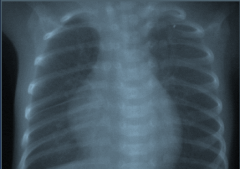
A baby delivered by a caesarean section presents with respiratory distress. This is his radiograph. What is the most likely diagnosis ?
|
Wet lung or transient tachypnoea of the newborn.
|
|
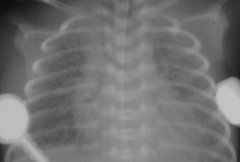
This radiograph is from a newborn with signs of respiratory distress. What is the most likely diagnosis ?
|
Hyaline membrane disease.
|
|
|
Discuss the technical assessment of a chest radiograph.
|
The following should be assessed:
1. Rotation 2. Lung volumes 3. Non-lordotic 4. Exposure |
|
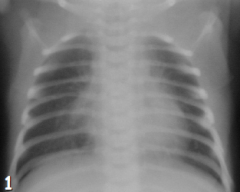
Assess the technical aspect of the following radiograph. What is wrong with it ?
|
Nothing.
|
|
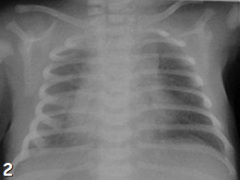
Assess the technical aspect of the following radiograph. What is wrong with it ?
|
It is a rotated radiograph.
|
|
|
How would you recognize hyperinflated lungs on a radiograph (with regards to neonates) ?
|
The diaphragm normally is at the height of the 8th-9th posterior rib endings or 6th anterior rib endings.
|
|
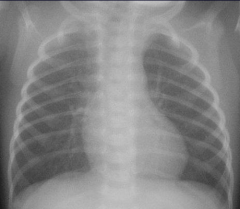
Comment on the lung volume of the following radiograph.
|
The lungs are hyperinflated.
|
|
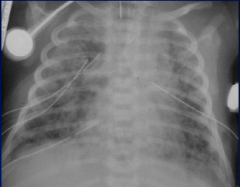
A neonate presents with respiratory distress. This is the radiograph. What is the most likely diagnosis ?
|
Meconium aspiration syndrome.
|
|
|
Discuss how you would determine the cardio thoracic ratio.
|
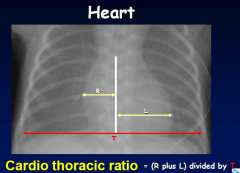
< 60% is normal
|
|
|
You took a radiograph of the chest of a neonate. The radiograph shows the heart to be a 'egg-on-side' shape. What is the most likely diagnosis ?
|
TGA (Transposition of the great arteries).
|
|
|
During the inspection of a radiograph, which structures should you be looking at ?
|
1. Artefacts
2. Skeletal 3. Soft tissue 4. Heart 5. Diaphragm 6. Thymus 7. Lungs |

